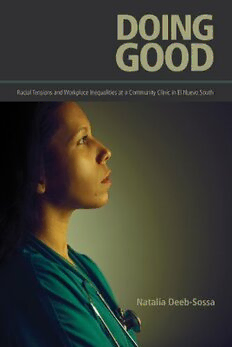
Doing Good: Racial Tensions and Workplace Inequalities at a Community Clinic in El Nuevo South PDF
Preview Doing Good: Racial Tensions and Workplace Inequalities at a Community Clinic in El Nuevo South
Doing Good Doing Good Racial Tensions and Workplace Inequalities at a Community Clinic in El Nuevo South Natalia Deeb-Sossa tucson © 2013 The Arizona Board of Regents All rights reserved www.uapress.arizona.edu Library of Congress Cataloging-in-Publication Data Deeb-Sossa, Natalia. Doing good : racial tensions and workplace inequalities at a community clinic in El Nuevo South / Natalia Deeb-Sossa. pages cm Includes bibliographical references and index. ISBN 978-0-8165-2132-6 (cloth : alk. paper) 1. Social status—Health aspects—North Carolina. 2. Equality—Health aspects—North Carolina. 3. Community health services—North Carolina—Employees. 4. Discrimination in employment. 5. Hispanic Americans—North Carolina. I. Title. RA418.5.S63D44 2013 331.7’61362109756—dc23 2012030853 Publication of this book is made possible in part by the proceeds of a permanent endowment created with the assistance of a Challenge Grant from the National Endowment for the Humanities, a federal agency. Manufactured in the United States of America on acid-free, archival-quality paper containing a minimum of 30% post-consumer waste and processed chlorine free. 18 17 16 15 14 13 6 5 4 3 2 1 Well, believe it or not, I was sitting in church one Monday night and I had been praying about a job, been praying and been praying for a clinical job. This is something I’ve always wanted to do, was work in the clinic. I always wanted to work with babies. Really with people, but babies particularly. So, one Monday night at church I didn’t cut my cell phone off. I normally do. My cell phone rung and it was a friend of mine called me and says “Look, I got a phone call from a friend saying her friend has a job opening where she worked at. If you want the job, you need to go.” And that’s how I got the job. . . . I got the call that Monday night. I was there on the Tuesday and hired on Tuesday. . . . And where I work at it’s mostly Latino, Spanish-speaking people. I do not speak Spanish, but I understand it very well. And I still enjoy working with them. A lot of the patients there now have gotten comfortable with me and they know that I don’t speak it. So, it still makes it all good. Yeah. . . . And it’s a good place to come to because our doctors are very good. They’re very good doctors to work for. . . . I think the clinic is a good clinic. A lot of people that doesn’t have the money, that can’t afford it, [the clinic] helps those people and I think that’s a wonderful thing. It’s a wonderful thing to work here and be a part of this. —From an interview with African American Medical Assistant (II), “Eva” Contents List of Illustrations ix Acknowledgments xi 1. Introduction: Meaningful Work and Moral Identity 1 2. “El Nuevo South”: The Case of North Carolina and the Community Health Center Program 21 3. Threats to Moral Identity and Disparity in “Moral” Wages 44 4. Moral Identity and Racial Solidarity: How Lower-Status Workers Fashion a Superior Self 61 5. “Neediest of the Needy”: How Midlevel-Status Workers View Their Work as “Moral” 84 6. “Working in the Trenches”: How “Doing Good” Helps Higher-Status Staffers Build Their Moral Identity 107 7. Moral Identity Construction and New Ethnic Relations 126 References 145 Index 157 Illustrations 1. Care Inc.’s organizational structure 35 2. Care Inc.’s floor plan 39 ix
